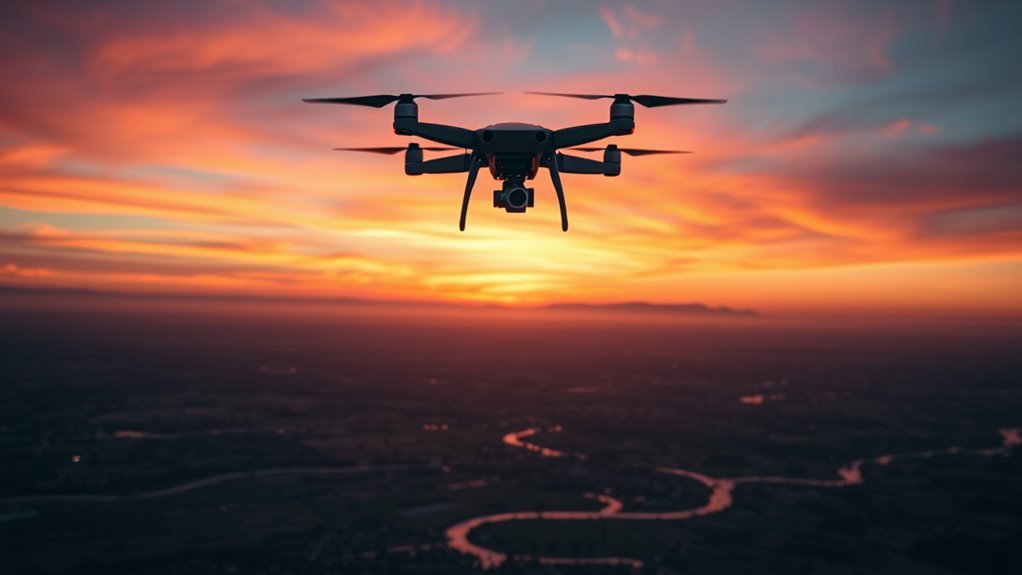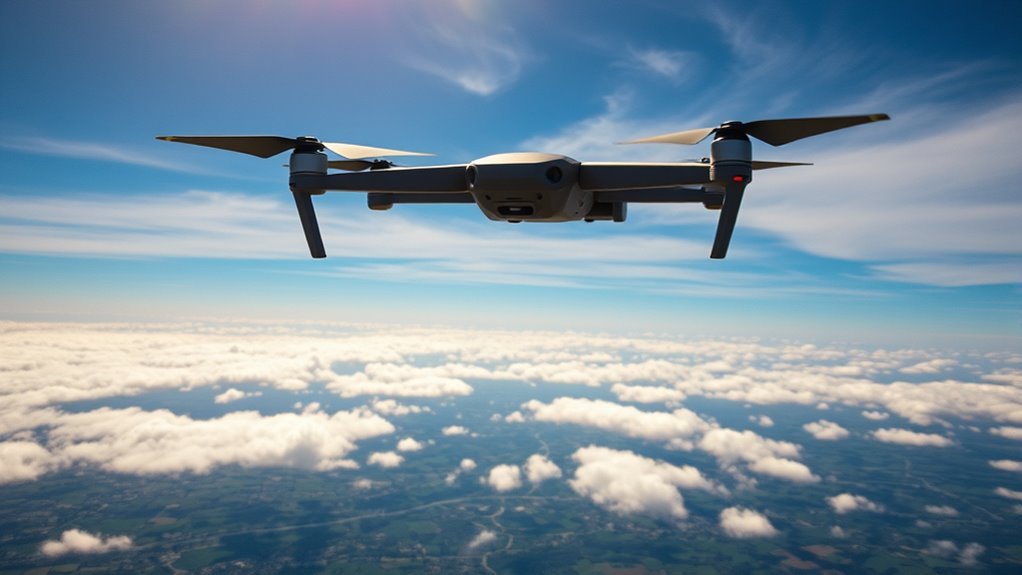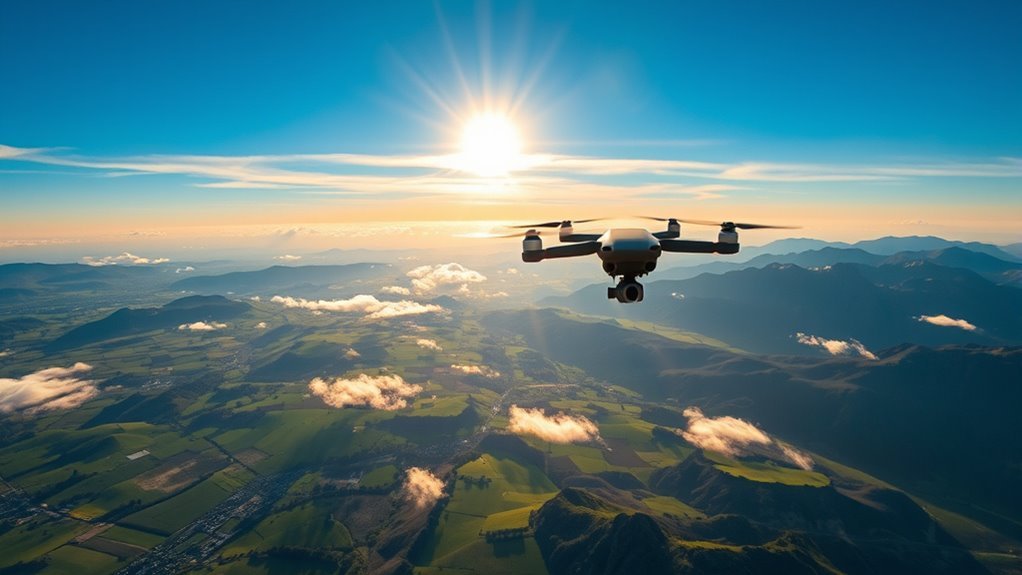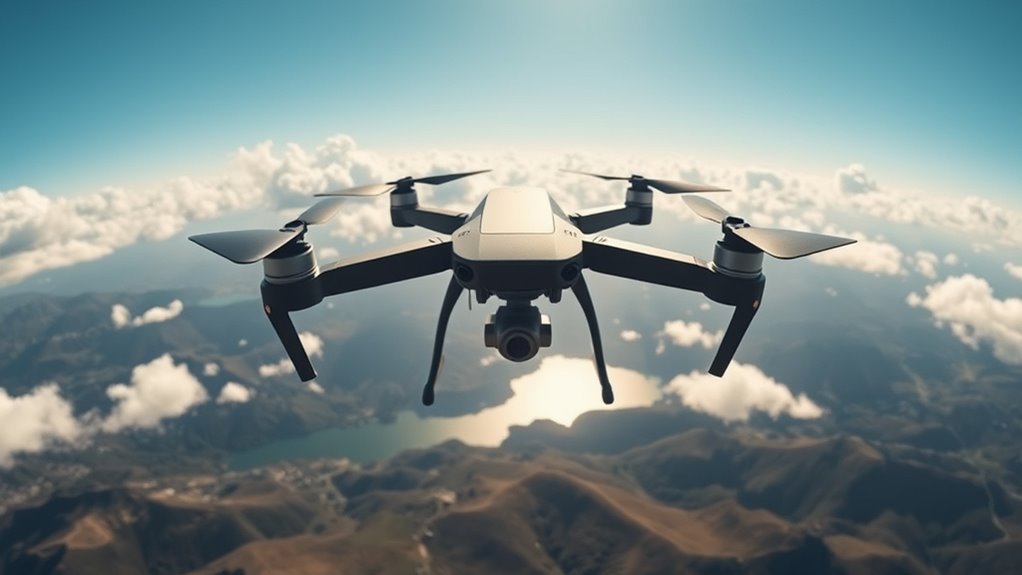Drones typically fly up to 400 feet above ground level, as mandated by FAA regulations. However, you must also consider state-specific altitude restrictions and no-fly zones that may apply. Various factors like drone type, weight, battery life, temperature, and environmental conditions can affect performance at these altitudes. It’s essential to follow best practices for safe operation to avoid legal penalties. To navigate these complexities effectively, there’s more you should explore.
Legal Regulations Governing Drone Altitude

While you might think flying drones at any altitude is permissible, legal regulations impose strict limits on how high you can operate these devices. Federal regulations, specifically those outlined by the Federal Aviation Administration (FAA), generally restrict drone operations to a maximum altitude of 400 feet above ground level. This limit guarantees safe airspace management and minimizes risks to manned aircraft. Additionally, state laws may impose further restrictions, varying by jurisdiction, that could affect your operational ceiling. In Connecticut, for instance, operators must also be aware of no-fly zones that could further limit where they can legally fly. It’s essential to familiarize yourself with both federal and state regulations, as violating them can lead to significant penalties. Understanding these legal frameworks is critical for maintaining your freedom to fly while guaranteeing compliance with safety standards. Furthermore, it is crucial to check for temporary flight restrictions before each flight to ensure you adhere to all regulations.
Technical Specifications of Drones

Understanding the technical specifications of drones is essential for optimizing their performance and ensuring they meet your operational needs. Different drone types, from quadcopters to fixed-wing models, have unique specifications that can influence their altitude measurements and flight capabilities.
Grasping drone specifications is crucial for enhancing performance and aligning with specific operational requirements.
- Weight Capacity: Heavier drones may have reduced altitude performance due to increased drag.
- Battery Life: A drone’s battery life affects how high and how long it can operate effectively.
- Sensor Technology: Advanced sensors can enhance altitude stability and navigation accuracy. Additionally, battery life is crucial as it directly impacts the drone’s altitude capabilities and operational range.
Environmental Factors Impacting Altitude

As altitude capability greatly depends on various environmental factors, it is vital to evaluate how elements like air density, temperature, and wind conditions can affect a drone’s performance. High temperatures can decrease air density, leading to reduced lift and less efficient propulsion, thereby limiting your drone’s altitude. Conversely, cooler temperatures generally enhance lift but can also decrease battery efficiency. Weather conditions, such as strong winds, can create turbulence, making it difficult for your drone to maintain stability at higher elevations. Understanding these altitude effects is important for maximizing your drone’s capabilities. By considering these factors, you can optimize your flight plans and truly enjoy the freedom of steering through the skies. Additionally, signal strength can also influence a drone’s ability to operate effectively at higher altitudes, as weaker signals may lead to navigation errors.
Best Practices for Safe Flight
To secure a safe and successful flight, it is crucial to adhere to best practices that prioritize both drone integrity and pilot responsibility. Start with a thorough pre-flight checklist to verify all systems function correctly. This includes checking battery levels, GPS signals, and camera settings.
Maintain altitude awareness; know the maximum limits for your area and adjust your flight plan accordingly. It is essential to understand the importance of registration requirements to ensure compliance with local laws.
- Always fly within visual line-of-sight.
- Avoid crowded areas and restricted zones to minimize risk.
- Regularly update your drone’s firmware for peak performance.
Additionally, ensure that your drone is properly registered to comply with legal requirements, as this not only protects you from potential fines but also promotes safety in the airspace.
Case Studies of Altitude Limits in Action
Adhering to altitude regulations not only guarantees safety but also allows for effective operational planning. In real world scenarios, you’ve likely faced altitude challenges that require careful navigation of airspace restrictions. For instance, a commercial drone operator might encounter no-fly zones near airports, necessitating adjustments in flight paths to avoid penalties. Similarly, search and rescue missions often demand higher altitudes for broader coverage but must comply with local regulations to maintain safety and coordination. Understanding these altitude limits can help you optimize your drone’s capabilities while remaining compliant. By analyzing specific case studies, you’ll gain insights on how to tackle altitude challenges effectively, assuring both freedom of operation and adherence to the law in your drone endeavors. Additionally, being aware of state and local laws can further enhance your operational strategy and mitigate legal risks. It’s also important to consider signal strength as a critical factor in determining the maximum altitude a drone can effectively operate at.
Frequently Asked Questions
What Are the Best Drones for High-Altitude Flying?
Imagine soaring like a hawk. For high-altitude drones, consider models with robust drone specifications, like the DJI Matrice 300 or Autel Evo Lite, offering advanced features to tackle the challenges of elevated flights efficiently and safely.
Can Weather Conditions Affect Drone Altitude Performance?
Yes, weather conditions can greatly affect your drone’s altitude performance. High winds increase wind resistance, while thermal currents can cause altitude fluctuations, impacting stability and control. Monitoring these factors is essential for safe, effective flying.
How Do Altitude Limits Vary by Country?
Altitude limits for drones vary considerably worldwide; for instance, the U.S. allows up to 400 feet. International regulations differ based on drone classification, impacting your operational flexibility and freedom depending on the country you’re in.
What Happens if a Drone Exceeds Altitude Limits?
If you exceed altitude limits, you risk violating drone regulations, which can lead to fines or confiscation. Prioritizing altitude safety is essential for maintaining operational freedom and ensuring compliance with aviation laws and community standards.
Are There Altitude Limits for Drone Racing Events?
In drone racing, altitude regulations often cap heights at around 400 feet, ensuring safety and fairness. Surprisingly, over 70% of racers adhere to these limits, highlighting a commitment to responsible flying in competitive environments.

